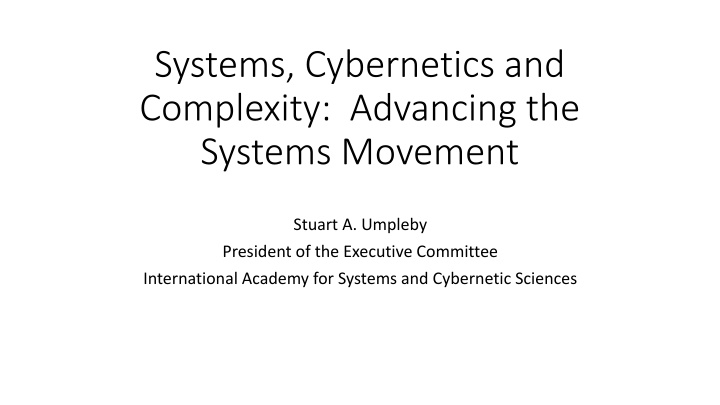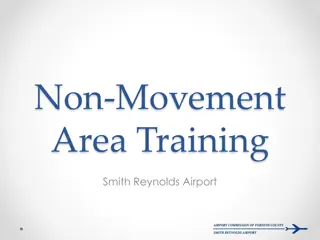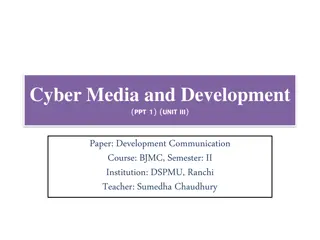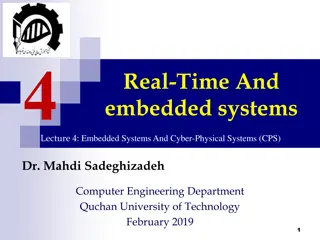Advancing Systems and Cybernetics Movement
Systems, cybernetics, and complexity fields are evolving with advantages like thriving journals and increasing interest globally. Despite challenges like confusion with computer science and lack of funding, these fields continue to progress with new associations and methods.
Download Presentation

Please find below an Image/Link to download the presentation.
The content on the website is provided AS IS for your information and personal use only. It may not be sold, licensed, or shared on other websites without obtaining consent from the author.If you encounter any issues during the download, it is possible that the publisher has removed the file from their server.
You are allowed to download the files provided on this website for personal or commercial use, subject to the condition that they are used lawfully. All files are the property of their respective owners.
The content on the website is provided AS IS for your information and personal use only. It may not be sold, licensed, or shared on other websites without obtaining consent from the author.
E N D
Presentation Transcript
Systems, Cybernetics and Complexity: Advancing the Systems Movement Stuart A. Umpleby President of the Executive Committee International Academy for Systems and Cybernetic Sciences
The current state of our fields (advantages) Several journals are prospering An increasing number of books are being published There is interest in the field abroad The large systems program of the Open University in UK New, seemingly similar fields and societies are being created
The current state of our fields (disadvantages) People do not know what cybernetics means People confuse cybernetics with computer science and AI No regular government funds for cybernetics research Very few educational programs in cybernetics (mostly abroad) Little interest in the unification of science
Stories being told about our fields In the last few years I have heard several people say that systems science and cybernetics have died They have been succeeded by the field of complexity which includes everything that was of value in those two fields and complexity has gone farther However, what I see is that associations, journals and conferences in systems and cybernetics are continuing, even increasing Associations, journals, and conferences in complexity have been added The questions being asked and the methods being used are different in systems, cybernetics, complexity
Three Neighboring Fields 1 Cybernetics Systems Complexity Origin of the field Macy Conferences, 1946- 1953, American Society for Cybernetics founded, 1964 An informal meeting within the 1954 meeting of the American Association for the Advancement of Science in Berkeley, California 1984, Santa-Fe Institute founded (first meeting 1985) Early authors W. McCulloch, N. Wiener, A. Rosenblueth, M. Mead, G. Bateson, H. von Foerster, H. Maturana Ludwig von Bertalanffy, K.E. Boulding, Anatol Rapoport, James G. Miller, Ralph Gerard, Jay Forrester, Edwards Deming M. Gell-Mann, G. West, R. Axtell, B. Arthur, J. Holland, S. Kauffman, S. Wolfram Definition of field Describe control and communication in animals, machines and social systems; create a science of purposeful systems Identify the common features of systems. A living system processes matter, energy, and information. It evolves over time and adapts to its environment New entities and patterns of behavior emerge when many agents interact and adapt to each other and their environments Purpose Create a science of perception, regulation, learning, adaptation, goal formulation, and understanding Create a general theory of systems and a variety of approaches to systems analysis Identify the unseen mechanisms and processes that shape evolving worlds
Three Neighboring Fields 2 Cybernetics Systems Complexity Methods Three fundamental models describe 1) regulation, 2) self-organization, and 3) reflexivity Systems engineering, system dynamics, causal loop diagrams, flow diagrams, process improvement methods What are the structures and processes in living systems? What is essential for life? Rigorous logical, mathematical, computational methods A key question How does the brain understand the world and itself? How can we create self-governing societies? How can we create a reflexive science? Reflexivity operates on two levels observing and participating How do order and novelty emerge in the world? Internal mechanisms Miller's 19 critical subsystems -- e.g. input information, ingestor for matter- energy, decoder, encoder, matter- energy storage, reproducer, supporter, transporter, etc.; These processes occur on 8 levels: cell, organ, organism, group, organization, nation, supranational system, world Increases in complexity require two processes: creating new variety and selecting appropriate variety; Describe the rules governing how agents interact transducer for
Three Neighboring Fields 3 Cybernetics Systems Complexity Locus of contribution Extensions of philosophy Share theories and methods for analyzing systems with other disciplines Identify instances of processes such as evolution, adaptation, cognition Cognition is a perception and decision process in living systems Complexity lies in the system observed Extensions of mathematics How science advances Expand the realm of inquiry by adding a new dimension Find the underlying mechanisms of emergence Conception of Cognition Cognition is one aspect of autopoiesis Cognition emerges in some biological processes Conception of Complexity Complexity lies in multiple conceptualizations of a system of interest which are created by people who have an interest in that system and its affect on the world Complexity emerges in some systems as a result of the interactions among elements in the system
What future do we want? Do we want systems science and cybernetics to continue? Should these fields be subsumed under complexity? How should the fields be described on college campuses? Can the three fields cooperate on conferences and curricula? The Academy (www.iascys.org) is beginning to include complexity scholars
Trends that support attention to our fields Increasing interest in climate change and its consequences Concern about growing numbers of refugees Concern about loss of species and habitats Preparations for more frequent storms and floods and rising sea level Continuing interest in communicating across disciplines The continuing growth of the internet Increasing use of AI and data analytics Interest in the unification of science
Problems we need to work on More educational programs in systems and cybernetics are needed More young people are needed to learn and extend the work that has been done Our fields are not well-known
Contact information Stuart A. Umpleby, Professor Emeritus Department of Management The George Washington University Washington, DC 20052 USA blogs.gwu.edu/umpleby umpleby@gmail.com
A presentation at the annual meeting of the International Society for the Systems Sciences Oregon State University Corvallis, OR June 27 - July 2, 2019























